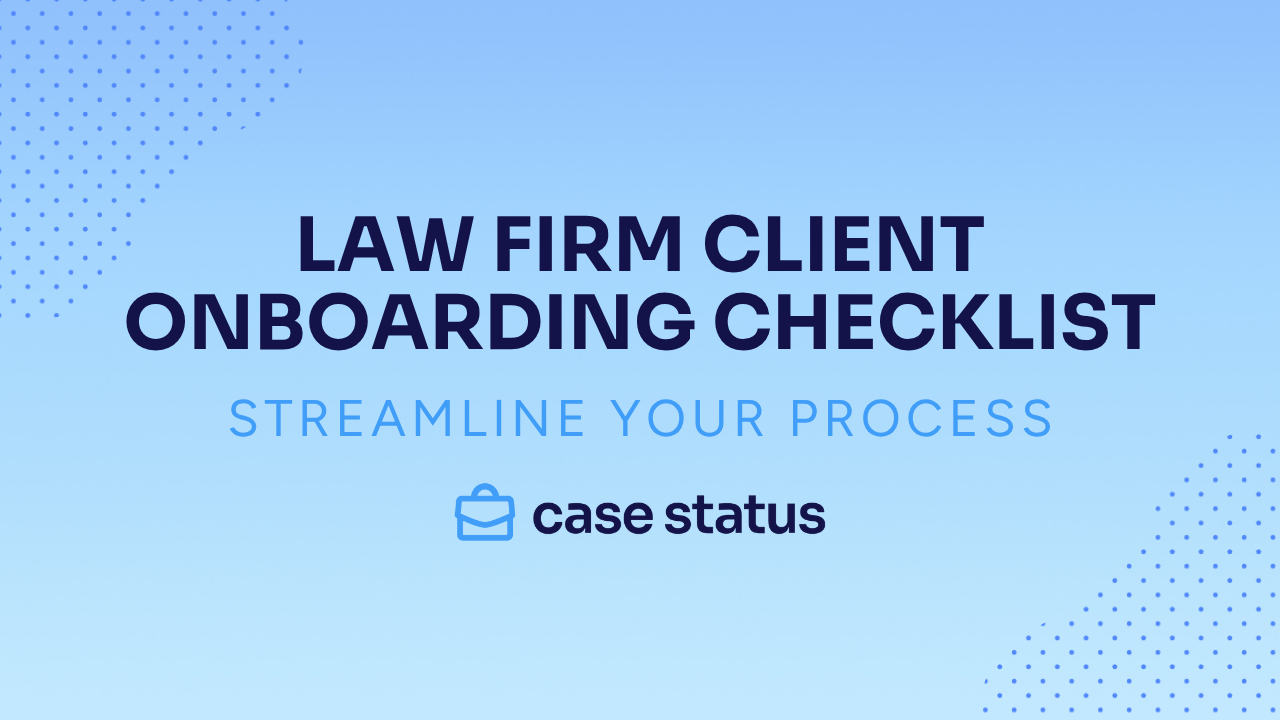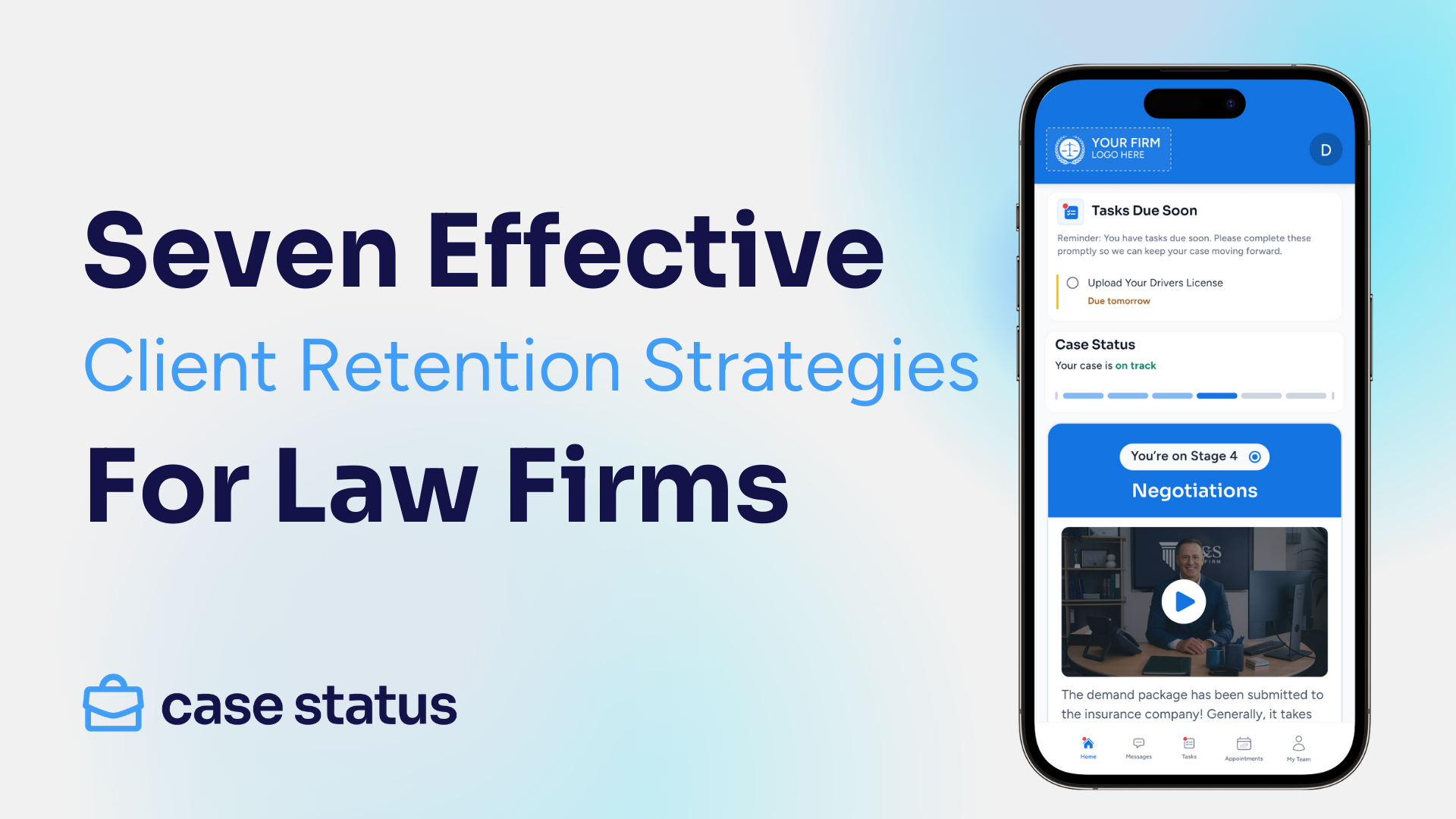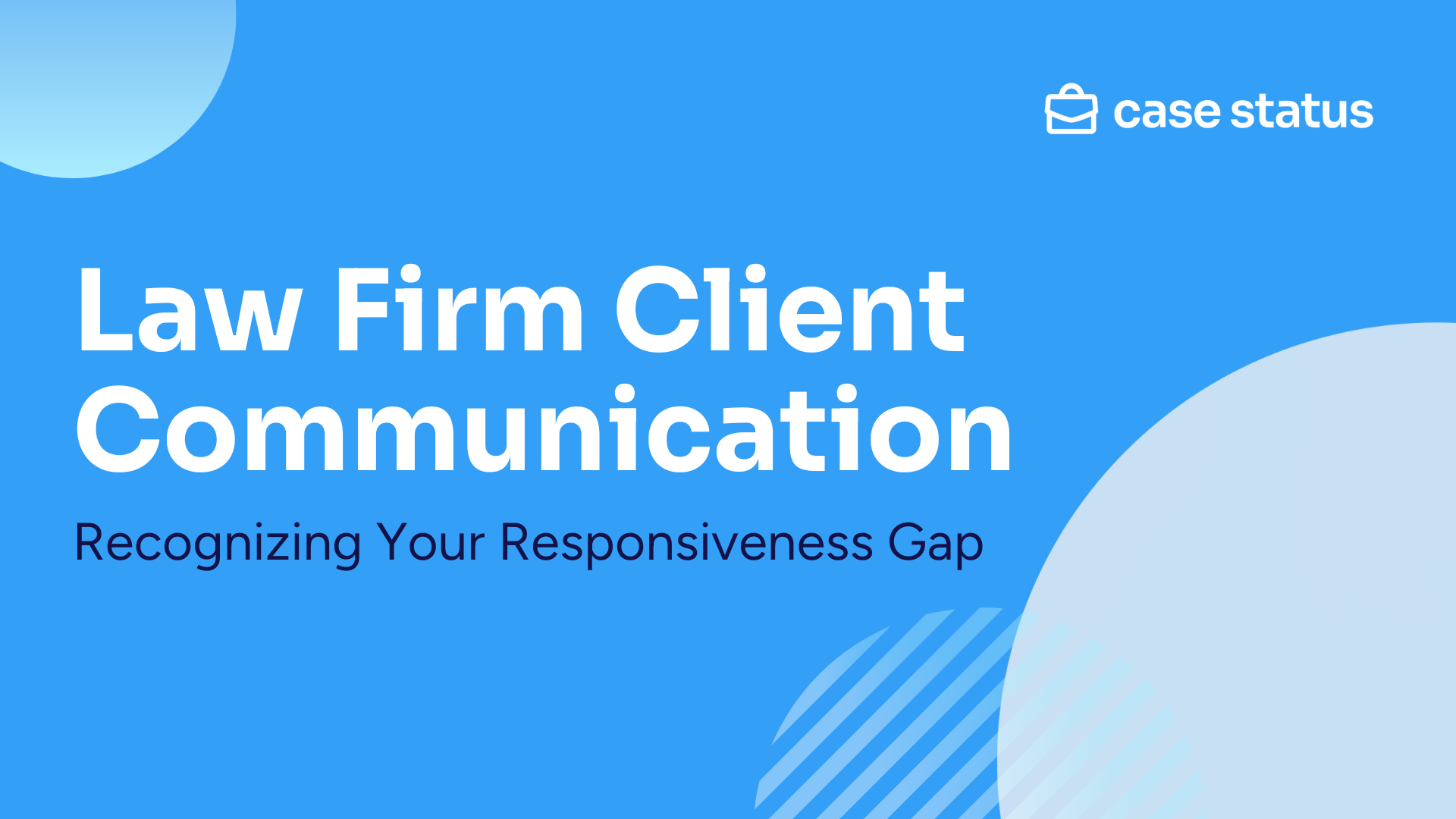
A strong onboarding process turns new clients into confident partners and keeps your team out of reactive mode.
A clear checklist reduces the flood of “What’s happening with my case?” calls, prevents bottlenecks (missing documents, unclear next steps), and helps you retain both clients and staff.
Firms that pair structured onboarding with modern client-communication tools see measurable wins.
Case Status’ 2025 Legal Client Experience data shows firms save 1,329 hours per year when communications and routine updates run through integrated, AI-driven automations, and clients report less anxiety when they know what’s next.
Your checklist should cover three outcomes on day one:
- Capture complete information and signed agreements.
- Set expectations for updates, timelines, and how to reach your team.
- Move every client into a single, secure channel (ideally your app), so messages, documents, and tasks live in one place.
Ready to build (or refine) your onboarding? Below, we’ll outline a simple, repeatable process that reduces inbound volume, accelerates early milestones, and creates a first-week experience clients remember for the right reasons.
How to Optimize the Onboarding Process & Manage Expectations
Onboarding sets the tone for the entire engagement.
A straightforward and respectful process gathers what you need upfront, explains how the relationship will work, and reduces the “just checking in” calls that bog teams down.
Collect Complete Information Before the First Meeting
Send a short digital packet that includes conflict-check details, ID verification, contact preferences, language preference, and the specific documents you’ll need (e.g., medical records authorization, insurance info). E-forms with e-signature keep everything consistent and prevent missing pieces later.
Run a Structured Initial Consultation
Share an agenda in advance and stick to it:
- Goals and scope.
- What happens next week, next month, and at major milestones.
- Who to contact for what.
- Where updates will appear.
Use plain language; avoid legal jargon. Close by confirming the next step and the exact date clients should expect their first update.
Be Explicit About Fees and Billing Rhythm
Explain the fee structure, retainers, payment options, and when invoices are sent. Show a one-page example invoice, so clients know what each line means. Clarity here cuts down disputes and extra calls later.
Set Communication Rules That Reduce Anxiety
Agree on the primary channel (app or portal preferred), expected response times, and when a “no-update update” will arrive during quiet phases. The 2025 legal CX report highlights that firms achieving a 5-6 hour response benchmark see stronger satisfaction, you can use this target to anchor expectations.
Build Cultural Competence Into Day One
Ask about pronouns, language, and accessibility needs in your intake. Provide AI-powered translation for all messages and materials, and offer interpreters as needed. Ensure all explanations, particularly in sensitive practice areas, are trauma-informed and in plain language. This isn’t just courteous; it prevents misunderstandings that lead to churn.
Channel Frequent Inquiries Into a Single Source of Truth
Give every client access to your portal/app on day one with a welcome message, a simple timeline, and a live checklist of what you need from them. When clients know where to look and see progress in real time, follow-up calls drop and first-week momentum improves. For broader operational guidance that supports this, see our guide to how to manage a law firm.
Document and Confirm
After the consult, send a short recap: what you heard, what you’ll do next, what the client owes you (documents, forms), and when they’ll hear from you again. Logging that summary to the matter record keeps the team aligned and reduces internal “status” chatter.
3 Best Practices for Effective Client Onboarding
The quickest way to turn new matters into confident relationships is to make onboarding predictable. These three practices create a consistent handoff from prospect to active client — and keep early momentum high.
Tip: For deeper context on modern client portals, see the best client portals for law firms and what is a client portal used for?
1. Establish Files Immediately With Standardized Intake Procedures
Create a single, repeatable sequence that triggers as soon as a client responds with a “yes.”
- Welcome packet + intake forms: Send a concise welcome message, conflict-check details, ID verification, and matter-specific questionnaires.
- How your firm works: In one page, explain who does what, how to reach the team, when to expect updates, and what the first 30 days look like.
- Set up the matter record right away: Open the file in your client management system (CMS), assign an owner and backup, attach the intake docs, and schedule the first status touchpoint before the client leaves (or logs off).
Consistent intake removes guesswork, captures critical facts the same way every time, and shows clients you are organized from day one.
2. Establish Clear Communication Protocols
Onboarding is the moment to define how you’ll stay in touch.
- Choose one primary channel: Pick a system that integrates directly with your CMS, provide portal and app access on day one, and explain that all messages, documents, and updates will live there. This keeps conversations complete, eliminates double entry, and makes progress easy to track 24/7.
- Set expectations: State your typical response window, who answers what (attorney versus case manager), and how “no-update updates” work during quiet phases.
- Accessibility and preferences: Capture language and accessibility needs, confirm notification settings, and offer alternate formats when appropriate.
A single source of truth lowers client anxiety and cuts repeat questions, while clear timing standards help your team meet (and measure) service goals.
3. Complete All Administrative Setup During Initial Meetings
Finish the paperwork and logistics up front so the case can move immediately.
- Agreements and payments: Execute engagement letters via e-signature, confirm fee terms, and collect a payment method or retainer as applicable.
- Authorizations and records: Obtain HIPAA and medical releases, employment or insurance authorizations, and any other required permissions, so requests can go out the same day.
- Document checklist: Tell clients exactly what to upload first, such as photos, bills, and prior correspondence, and show where to do it in the portal.
- Calendar the first milestone: Book the next appointment or court date, and send an automatic reminder schedule while the client is present.
Completing admin tasks in the first meeting avoids delays, reduces back-and-forth, and keeps everyone aligned on what happens next.
Post-Onboarding Follow-Up and Retention Strategies
The first 30-90 days after onboarding either confirm confidence or create doubt. Maintain momentum by making the portal your default channel, establishing a consistent update cadence, and soliciting feedback at regular intervals.
Automations help your team deliver this rhythm without extra inbox work. Use them to schedule reminders, send “no-update” updates during quiet phases, and trigger brief surveys after key milestones.
As these touchpoints accumulate, clients feel informed and cared for, which leads to stronger reviews, referrals, and repeat engagements. If you’re ready to operationalize this cadence, see how to scale your client services.
A simple plan works best:
- Ongoing communication: Route all messages, documents, and checklist items through the portal, so clients always know where to look.
- Regular case reviews: Hold short internal reviews (e.g., every 30 days) to confirm next steps and schedule upcoming client updates.
- Targeted education: Share plain-language resources that match the current stage (e.g., “What to expect before mediation”), reducing avoidable questions.
- Feedback loops: Send quick, one-question check-ins after major updates; follow up with detractors within 24 hours, and thank promoters with an easy review link.
- AI sentiment insights: Use AI capabilities, like those found in Case Status, to analyze client message sentiment and flag potential frustration early, so your team can respond proactively.
How to Streamline Client Onboarding With Case Status
Effective onboarding is the first proof of your firm’s professionalism. Case Status turns the onboarding process into a simple rhythm: invite, orient, collect, confirm. Then, keep clients moving with timely prompts in one secure channel, supported by AI-driven communication and automation.
Let’s take a deeper look.
What Derails the First 30 Days (and How to Fix It)
Late Attorney Contact
If the lead attorney doesn’t connect within 24 hours, confidence drops fast.
Case Status Fix: Trigger an automatic welcome in the app the moment a client signs, introduce the attorney with a short bio, and schedule the first check-in on the calendar. The message, appointment, and follow-up all live in the same place that the client will use throughout the case. AI-powered recommended responses can also help attorneys reply quickly in a professional, consistent tone.
Vague Expectations
Clients don’t know what you need, how to reach you, or when they’ll hear from you.
Case Status Fix: Use a standardized “Day-One” message: who to contact for what, expected response windows, what happens next week or month, and when a “no-update” update will arrive during quiet phases. AI sentiment analysis helps surface if clients remain uncertain, prompting proactive outreach before concerns grow.
Little Education or Orientation
Clients feel lost in terminology and process.
Case Status Fix: Load a short, plain-language timeline and FAQs into the app. At each stage, send a brief explainer (“What to expect before records arrive”), so clients feel prepared. AI case summaries can automatically summaries of case history, client sentiment, blockers that need to be addressed, and next steps.
Channel Confusion
Calls, texts, and emails scatter across tools and people.
Case Status Fix: Consolidate into the app from day one. Invite the client during intake. Confirm that updates, documents, and messages will be here; then, stick to it. AI-powered urgency filtering ensures critical client messages in the app rise to the top, so nothing slips through the cracks.
Improving Administrative Setup
Picture this: The attorney asks for documents at the end of the meeting; then, the staff chases by email and voicemail. The client isn’t sure what’s required, what’s optional, or where to send it. Progress stalls until paperwork arrives.
With Case Status: As soon as the engagement is signed, the client sees an on-screen checklist (e.g., photo ID, insurance info, medical releases). Missing items are clearly flagged in red. E-signature packets go out immediately. AI reminders escalate politely if uploads lag, and overdue tasks can be highlighted for staff prioritization without manual tracking.
Communication & Expectations: Boundaries That Build Trust
Explain during onboarding, for example: “This is our primary channel for updates and documents. Typical reply time is X. If you prefer a call for complex issues, we’ll still place a written recap in the app, so everything is in one record.”
If a client pushes for off-channel texting or email, acknowledge the preference, take the call if needed. Then, log the summary in the app, and point them back to the centralized thread. This keeps the file complete and reduces confusion later.
Technology & Efficiency: Practical Tools That Speed Day One
- Instant authorizations: Capture HIPAA and medical releases on a mobile phone with e-signature, so record requests go out immediately. Firms using a mobile client app commonly reach 80-90% client adoption, meaning most clients actually see updates where they live, on their phones.
- Document capture: Clients snap photos of bills, IDs, or forms directly in the app; optical character recognition (OCR) and file-type checks eliminate the need for back-and-forth.
- Translation: When needed, send messages in the client’s preferred language, so instructions are clear the first time. Built-in AI translation ensures accuracy and speed.
- Scheduling: Confirm the first attorney touchpoint before the client leaves; automated reminders handle the countdown.
How to Introduce Case Status to Clients
Here's a simple way to bring clients into Case Status quickly and easily: “You’re in! Your app shows exactly what we need and what we’ll handle next. Checklists are ready, your first appointment is set, and messages sent here are routed directly to our team. Everything related to your case (updates, documents, questions) stays in one secure place.”
Close the loop by asking “How are we doing?” early on. A quick NPS check-in after the first milestone catches confusion before it becomes frustration. AI sentiment analysis provides added context by detecting shifts in tone across client feedback, so your team can step in at the right time.
Turn Onboarding Into Long-Term Success
A clear onboarding checklist turns day one into momentum. Clients know what to do, your team knows what’s next, and cases move without constant chasing.
Put everything in one secure channel, set expectations early, and automate the nudges that keep tasks on track. The payoff: fewer calls, faster progress, and happier clients who stick with you and refer others.



.png)